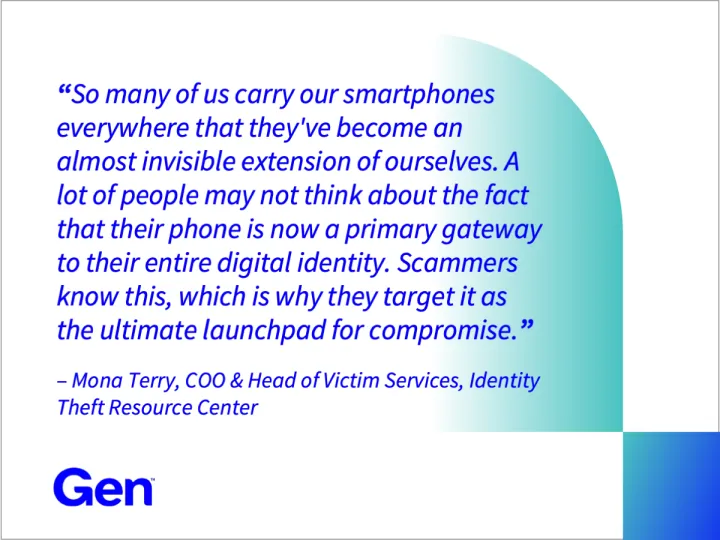Why Your Phone Is a Target for Scammers


Your smartphone isn’t just a device — it’s your digital life in your pocket. It holds your identity, finances, messages, photos and connections. And that’s exactly why it’s one of the most valuable targets for scammers today.
As attacks grow more sophisticated, your phone has become both the key to convenience and the key that criminals want most. Working with our partners at the Identity Theft Resource Center (ITRC), we’re sharing what you can do to stay ahead.

1. Why smartphones are under attack
Everything in one place.
Your phone holds it all — emails, banking apps, social media, passwords, and even the codes that protect your accounts. If a scammer gains control, they can do more than compromise a single login — they can unlock your entire digital life.
Always on, always connected.
Smartphones travel with us across networks — public Wi-Fi, Bluetooth, cellular. That constant connectivity expands your exposure and gives scammers more opportunities to strike.
Built on trust.
We trust what our phones show us: texts, pop-ups, alerts, and notifications. Scammers exploit trust by blending into the everyday experiences we rely on — an “account locked” text, a “package delivery” notice, a security alert that feels routine.
The SIM factor.
Many accounts still tie security codes to your phone number. Through SIM swapping or “port-out” scams, attackers can hijack that number, intercept authentication codes, and reset passwords — all without needing access to your phone itself.
That’s why your phone isn’t just a target. It’s a launchpad for deeper compromise across your entire online footprint.
2. Common mobile scam tactics (and how they work together)
Scammers don’t just pick one tactic anymore — they blend them for maximum impact. Below are some of the most popular mobile scam tactics.
Robocalls and spoofed caller IDs
You get a call that looks local — maybe even familiar. The caller claims to be from your bank, a government office, or a tech support line. The goal? To pressure you into sharing information or taking immediate action.
Smishing (SMS phishing)
Text messages that look urgent — “Your account is locked,” “Confirm delivery,” “Claim your refund” — push you to click links or respond. Those links often lead to fake login pages designed to steal your information or install malware.
SIM swaps and number hijacking
By posing as you, scammers convince your carrier to transfer your phone number to a new SIM card. Once they control it, they can intercept calls, messages, and even two-factor authentication codes.
Fake or malicious apps
Some apps disguise themselves as harmless tools — a flashlight, photo editor, or game — but quietly request access to your contacts, camera, or text messages. Others are clones of legitimate apps that install malware when downloaded.
Voice phishing and deepfake Audio
With generative AI, scammers are now using cloned voices or synthetic recordings to impersonate people you know — or authority figures you’d normally trust. A familiar-sounding voice asking for a “quick favor” can be enough to trick even the cautious.
“One-Ring” and callback scams
You see a missed call from an unknown or international number. Calling back connects you to premium-rate lines or automated systems designed to keep you on the line — and charge you for it.
Often, these scams overlap — a fake app might prompt an SMS confirmation, or a smishing message might direct you to a malicious download. The goal is to create a believable chain of trust that leads to compromise.
3. Red flags that something’s off
Keep an eye out for these warning signs:
- Unsolicited calls or texts demanding immediate action
- Messages with typos, poor grammar, or odd formatting
- Links that don’t match official domains
- Apps requesting permissions they don’t need
- Alerts that your SIM or number is being activated elsewhere
- Suspicious short codes or incomplete phone numbers
- Caller IDs that mimic legitimate contacts
- Offers or prizes that feel “too good to be true”
- Pressure to act right away or risk losing access
When in doubt, take a step back and verify directly through official websites, phone numbers, or apps.
4. How to protect yourself
Lock down your phone and mobile account
- Use a strong passcode or biometric lock
- Enable full-disk encryption
- Ask your carrier to add a number lock or port freeze
- Use an authentication app instead of SMS-based codes whenever possible
- Set a unique PIN or passphrase with your mobile provider
Harden apps and permissions
- Download only from trusted app stores
- Review app permissions regularly and remove unnecessary ones
- Avoid sideloading or third-party app installations
- Use mobile security software to detect suspicious behavior
- Delete apps you no longer use
Stay skeptical and verify
- Don’t tap links in unexpected messages
- Contact organizations directly through official channels
- Block and report suspicious senders or numbers
Keep everything updated
- Regularly update your operating system and apps
- Use a VPN, like Norton, when on public wi-fi
- Avoid connecting to unsecured networks
- Back up your data securely so recovery is easy if something happens
Monitor and alert
- Turn on alerts for SIM changes, new logins, and suspicious activity
- Use identity monitoring tools, like LifeLock, to spot leaked credentials early
- Review bank and credit accounts regularly
- Consider freezing credit if you notice unusual activity
5. If you think you’ve been targeted
- Contact your carrier to freeze or reverse any SIM or porting requests.
- Change passwords and log out of all active sessions.
- Notify your bank or credit provider and request fraud protection.
- Report the incident to the Identity Theft Resource Center, the FTC, your state attorney general, or local law enforcement.
- Use identity restoration services to help clean up any fraudulent activity.
- Stay alert — scammers often follow up with new attempts after a successful breach.
Why this matters
At Gen, in collaboration with the Identity Theft Resource Center (ITRC), we’re tracking an unmistakable trend: mobile scams are scaling fast — powered by automation, AI, and social engineering that feels increasingly personal.
“At the Identity Theft Resource Center, we've seen firsthand the negative impact when a phone compromise leads to email account takeover, individuals being locked out of their social media accounts, or losing access to personal photos and documents,” said Mona Terry, COO & Head of Victim Services at the Identity Theft Resource Center. “These attacks don't just steal money; they steal identities and peace of mind. That's why we're here. If you've been targeted, we provide free, one-on-one assistance to help you navigate recovery, secure your accounts, and reclaim your digital life.”
Your phone is now the front line of digital trust. Protecting it means protecting your identity, finances, and peace of mind.